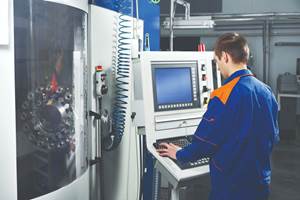Know Your Control
A new training center will enable Heidenhain to support its CNC users by ensuring that they are aware of all that the control can do. The value of some control capabilities don’t become apparent until they are seen in use.

Daniel Miller is the instructor at a new Heidenhain training facility where students receive hands-on instruction with company’s CNC on a five-axis machining center.
Soon, many builders selling machine tools with a Heidenhain control will offer vouchers for a week of free CNC instruction at the control maker’s Chicago-area U.S. headquarters. This voucher program is in development, the company says, and an important element of the program is already in place. I recently paid a visit to the company’s newly opened training facility in Schaumburg, Illinois, where students acquire hands-on experience with the control by running a five-axis Hermle machining center.
Getting new users familiar and comfortable with the CNC is only part of the goal of the company’s training, Heidenhain says. The company’s CNC is unfamiliar to many shops, so helping new users quickly adapt is certainly a benefit. However, the much larger benefit the company sees is in making sure that users are aware of the extent of what the control can do.
Leaving powerful control capabilities unused is too common, says company CNC training instructor Daniel Miller. He says he recently visited a shop machining blisks where he observed that the shop was accepting an unnecessarily light depth of cut because of chatter. He taught staff members there how to use the Active Chatter Control (ACC) feature of their CNC, which manipulates the machine’s feed drives to produce damping, thereby reducing the effect of chatter at frequencies up to 100 Hz. Thanks to this feature, the shop was able to increase its depth of cut and increase its productivity. Heidenhain did not make a new sale in order to bring about this success, because it involved applying a control capability the shop already owned.
A similar recent story involved a mold shop owner, Mr. Miller says. The shop owner recognized the value of ACC when he happened to be walking by a live demonstration of it at a trade show. The difference in cutting performance when the capability was turned on and off was audible, and he followed the sound to investigate. In his case, he did not have this capability on his own machine, but the shop was a Heidenhain user. He had the capability added as soon as understood the value.
Mr. Miller says a similar, related feature of the CNC is Adaptive Feedrate Control. This capability monitors spindle load and adapts the feedrate override accordingly. When used in conjunction with trochoidal milling, for example, it speeds the milling pass significantly, because all of the air cutting within each loop of the trochoidal path can be taken at a user-specified override of perhaps 150 percent, reducing cycle time.
The hands-on basic training course with the Heidenhain control in the new facility lasts 4.5 days. The company will offer an advanced course for experienced users as well, and the new facility also provides a setting for customized training for companies in search of this. The latest example is a medical device maker that has asked Heidenhain and Mr. Miller to train its machining staff in more advanced use of machine tool probing for machine verification and on-machine inspection.
Related Content
Understanding CNC Machine Accuracy and Repeatability
Properly evaluating machine tool capability requires understanding how the both user and the builder can influence precision.
Read MoreSwiss-Type Control Uses CNC Data to Improve Efficiency
Advanced controls for Swiss-type CNC lathes uses machine data to prevent tool collisions, saving setup time and scrap costs.
Read MoreTips for Designing CNC Programs That Help Operators
The way a G-code program is formatted directly affects the productivity of the CNC people who use them. Design CNC programs that make CNC setup people and operators’ jobs easier.
Read More6 Steps to Take Before Creating a CNC Program
Any time saved by skipping preparation for programming can be easily lost when the program makes it to the machine. Follow these steps to ensure success.
Read MoreRead Next
The Cut Scene: The Finer Details of Large-Format Machining
Small details and features can have an outsized impact on large parts, such as Barbco’s collapsible utility drill head.
Read More3 Mistakes That Cause CNC Programs to Fail
Despite enhancements to manufacturing technology, there are still issues today that can cause programs to fail. These failures can cause lost time, scrapped parts, damaged machines and even injured operators.
Read More
.jpg;width=70;height=70;mode=crop)









.png;maxWidth=300;quality=90)















